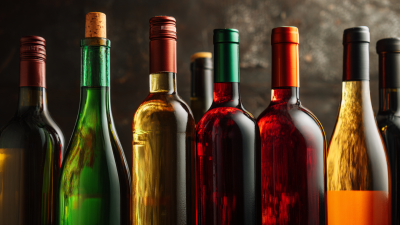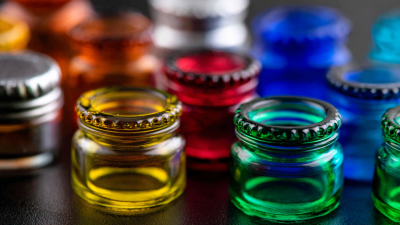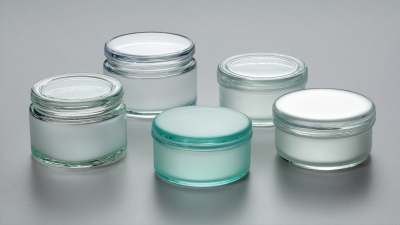
The evolution of wine bottles is a fascinating journey that mirrors the development of wine itself, reflecting cultural, technological, and aesthetic advancements. From the ancient clay amphorae used by the Greeks to the sleek glass designs dominating the market today, the transformation of wine bottles has significant implications for both producers and consumers.

According to the International Organisation of Vine and Wine (OIV), global wine consumption reached 244 million hectoliters in 2021, highlighting the importance of effective packaging in maintaining quality and enhancing the drinking experience. Additionally, a market analysis by Research and Markets indicates that the wine bottle packaging industry is expected to grow at a CAGR of 5.8% from 2021 to 2026.
Understanding the evolution of wine bottles not only provides insight into historical consumption patterns but also reveals emerging trends in sustainability and design that shape the future of wine marketing.
The historical significance of wine bottles can be traced back to ancient civilizations, where they were crafted using materials such as clay and glass. According to industry reports, the global wine packaging market is projected to grow significantly, with an expected CAGR of 4.5% from 2020 to 2025. This evolution reflects not only aesthetic preferences but also the necessity of preservation and transport.
Recently, discussions have sparked around the environmental impact of discarded items, including historical wine bottles. A prominent incident involved a YouTuber's clean-up initiative that unintentionally included bottles from the Japanese colonial period, generating public scrutiny. This highlights the delicate balance between safeguarding historical artifacts and maintaining ecological responsibility.
Tips for wine bottle collectors and enthusiasts would encompass researching the provenance of bottles before disposing them. Engaging in responsible recycling practices helps to respect historical legacies while contributing positively to the environment. Additionally, understanding the age and significance of certain bottles can enrich one's collecting experience and preserve culture for future generations.
The evolution of wine bottle production has been significantly influenced by the materials employed, ranging from ancient clay vessels to contemporary glass designs. Initially, ancient civilizations utilized clay amphorae for storage and transport, as evidenced by archaeological findings indicating that clay allowed for effective fermentation and aging of wine. These clay containers were widely used in regions like Mesopotamia and Egypt, where wine was an integral part of social and religious practices.
With advancements in technology and changing consumer preferences, glass became the dominant material for wine bottles in the late 17th century. According to the Global Glass and Ceramics Market Report, the glass wine bottle market is projected to grow by 4.4% annually from 2021 to 2025. Glass not only enhances the visual appeal of wine but also provides an inert barrier that helps preserve the wine’s flavors and aromas. The adoption of green and amber glass primarily stems from their ability to protect wine from sunlight, reducing the risk of spoilage. In recent years, innovations in eco-friendly production have gained traction, with many wineries opting for lighter bottles to decrease shipping emissions and overall carbon footprint, aligning with a growing trend towards sustainability in the wine industry.
| Material | Historical Use | Modern Applications | Advantages | Disadvantages |
|---|---|---|---|---|
| Clay | Used in ancient civilizations, like Mesopotamia and Egypt. | Rarely used now, but some artisans still create clay bottles. | Natural and breathable; enhances wine aging. | Fragile and porous; can lead to evaporation. |
| Glass | Became popular in the 17th century; replaced clay. | Currently the most common material for wine bottles. | Non-reactive; available in various shapes and colors. | Heavy and can break easily. |
| PET Plastic | Used in some modern applications; primarily for convenience products. | Increasingly popular for eco-friendly and lightweight bottles. | Lightweight and less fragile; recyclable. | May not preserve wine quality as well as glass. |
| Aluminum | First used in the wine industry for screw caps. | Now used for cans and innovative packaging. | Lightweight; protects against light and oxygen. | Perception issues may arise; less traditional. |
The shape of a wine bottle plays a crucial role not only in the presentation of the wine but also in its aging process and flavor profiles. According to a report by the Wine Institute, bottle shape can influence oxygen exposure, which is vital for wine maturation. For instance, taller bottles like the Bordeaux style typically have a narrower neck, resulting in less air contact and promoting a slower aging process. This is particularly beneficial for full-bodied reds, where gradual oxidation develops complex flavors over time.
Furthermore, recent studies have shown that the curvature and thickness of a bottle can affect how light interacts with the wine. Clear or lightly tinted bottles are subject to more light exposure, which can lead to premature aging or "light-struck" flavors, particularly in delicate whites. Conversely, darker bottles, such as those traditionally used for Cabernet Sauvignon, offer better protection against harmful UV rays, preserving the integrity of the wine's taste profile. As wine connoisseurs increasingly seek wines that reflect optimal aging characteristics, understanding the impact of bottle shapes becomes essential for both producers and consumers in the industry.
The evolution of wine bottle design has taken a remarkable turn toward sustainability and aesthetics in recent years. Modern innovations emphasize the use of sustainable materials, such as biodegradable and compostable options, which cater to the increasing consumer demand for eco-friendly packaging solutions. These advancements not only address environmental concerns but also elevate the overall aesthetic appeal, with designs that blend functionality with bold, striking visuals. As the packaging landscape continues to evolve, we see a growing trend where wine bottles are crafted to reflect modern masculinity and innovative artistry.

In addition to sustainability, the focus on premiumization has led to the introduction of unique packaging designs that captivate consumers. The use of recycled materials and cutting-edge production processes showcases a commitment to corporate responsibility while ensuring that the packaging is both attractive and practical. As the global alcohol packaging market grows, these innovations are set to redefine how wine is perceived and enjoyed, fostering a new appreciation for the intersection of design and environmental mindfulness. This shift signifies not only a trend but a cultural movement towards smarter, more responsible consumption in the wine industry.
Recent market research reveals shifting consumer trends and preferences in wine packaging that reflect broader changes in lifestyle and environmental consciousness. According to a report by the IWSR, the global wine packaging market is expected to grow by approximately 2.5% annually over the next five years, driven by the increasing demand for innovative and sustainable solutions. Younger consumers, particularly Millennials and Gen Z, are favoring lighter bottles and eco-friendly alternatives, seeking reduced carbon footprints without sacrificing quality. This demographic is also gravitating towards colorful and artistic labels that enhance visual appeal and storytelling.

Tips for producers looking to align with these trends: consider sourcing lightweight glass and exploring alternative materials like Bag-in-Box or Tetra Pak, which are more sustainable and practical for consumers. Additionally, embracing technology such as augmented reality on labels can attract tech-savvy buyers by providing interactive experiences that enrich their wine selection. Engaging with consumer communities on social media can also ensure that brands remain relevant and in tune with evolving preferences.
As sustainability takes center stage, the rise of canned wine exemplifies this shift. A report by Wine Intelligent indicated that 50% of consumers are open to trying wine in cans, especially for casual occasions. Not only is this packaging lightweight and recyclable, but it also caters to on-the-go lifestyles, appealing to the modern wine drinker who values convenience without compromising on taste.






